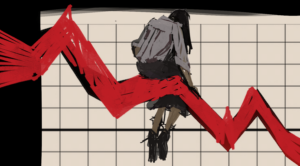“I do not want to be in a religion in which I am ‘allowed’ to have a crucifix… In people who are Catholics, or call themselves Catholics, I want the idea not only liked but loved and loved ardently, and above all proudly proclaimed.” – G.K. Chesterton
At Georgetown, unlike most universities in the United States, we are surrounded by crosses and crucifixes.
There’s a cross on top of Healy Hall and one on top of White-Gravenor, as well as crucifixes in many classrooms. Many people, irrespective of background, are probably not all that surprised to see so many crosses and crucifixes at the country’s oldest Catholic university; they’ve likely seen their fair share before coming here without giving them a second thought.
I didn’t think too much of them myself until two years ago when my roommate told me he thought they were a “disgusting” symbol. He wondered why Christians are content with depicting the gruesome death of their God. I didn’t know what to say. I had never considered that perspective before, but maybe that was because I had never taken the time to contemplate the significance of the crucifix.
Before we can understand the meaning of the crucifix, let’s look more closely at the man that crucifixes depict. His name was Yeshua, but he is more commonly known by the name of Jesus. What was the crime He committed that warranted crucifixion? He radically threatened the political structures of His time.
We Christians call him “Christ” because we believe him to be the Christos, a Greek translation of the Hebrew word Mashiach (anglicized as Messiah), which means “anointed one.” The Jews had been waiting for the Mashiach since the time of King David, when God promised Israel a king whose reign would never end. Throughout the Babylonian exile and the Roman occupation of Palestine, the Jews hoped for a Mashiach to overthrow their captors, defeat their enemies, and establish the supremacy of the throne of David forever. He was supposed to be a mighty figure who would conquer the world.
Now this doesn’t sound much like Jesus at all. Instead of overthrowing the Roman Empire, Jesus told the Jews to continue paying their taxes (Matthew 22:21). Instead of conquering enemies, Jesus told His followers to love their enemies and pray for their persecutors (Matthew 5:44). While some Jews accepted Jesus as the Mashiach and became the first Christians, others didn’t. Some in the elite brought Him to the Romans, who heard the Mashiach was to start a revolt against their empire.
And so Jesus was executed around the age of 33 by means of crucifixion, the most torturous method of execution devised by the Roman Empire. Instead of Jesus conquering the world, the world conquered Him on the cross. Sounds like a spectacular failure, doesn’t it?
Perhaps not. In Christianity, we believe Jesus’s death redeems us from sin and saves us from death by offering us eternal life. Put another way, through His death and resurrection, Jesus conquered death. We don’t call Jesus the Mashiach because He saved Israel from her captors, the Roman Empire, but because He saved all of humanity from its captor, death. By offering us eternal life in heaven, He does indeed establish a kingdom that will never end. Because of Jesus, we can proclaim with St. Paul, “Where, O death, is your victory? Where, O death, is your sting?” (1 Corinthians 15:55)
Still, why do Christians champion the instrument of Jesus’s demise in their churches and buildings? Crucifixion was used in the Roman Empire as a tool of fear and intimidation because it was the worst punishment the empire could inflict on a person. However, the early Christians adopted the crucifix as a symbol of their faith, quite possibly as a taunt akin to, “Is this the best you can do? My Lord already defeated this!” Indeed, the crucifix gave strength and courage to the early Christians, amid nearly three centuries of persecution, by reminding them how powerful, how truly mighty the Mashiach was, for He conquered the one thing that no one else could conquer.
The crucifix reminds us that, “God so loved the world that He sent His only Son, so that everyone who believes in Him might not perish but might have eternal life.” (John 3:16) In some Christian communities, a cross is used instead of a crucifix, the difference being that a cross doesn’t have Jesus’s body on it, whereas a crucifix does. The rationale behind crosses is that, since Christ is risen, there is no need to depict His dead body on the cross.
Nonetheless, Roman Catholics often use the crucifix, and for good reason. It is all too tempting to pass over Christ’s crucifixion, which is remembered on Good Friday, and skip straight to the joy of Easter, His resurrection. But then we risk forgetting the agony and pain Jesus endured “for us men and for our salvation,” as the Nicene Creed professes.
The crucifix, which bears Jesus’s body, reminds us that, while Jesus did suffer a gruesome death, He did so freely because He loves us. The crucifix isn’t meant to elicit disgust as my roommate suggested, but rather to remind us that Jesus freely chose to experience the most excruciating of deaths for our sake precisely because He is a God of self-sacrificial love. What could be more beautiful?
Gaudium et spes is coordinated by the Georgetown University Knights of Columbus. The Knights of Columbus is a Catholic, fraternal, and service organization. This column focuses on how Catholic values, principles, and teachings can inform the lives of all Georgetown students, regardless of faith. Additionally, this column attempts to facilitate dialogue about matters of faith and inspire conversations about topics that impact the daily lives of Hoyas, from national politics to campus news. Gaudium et spes appears online every other Friday.






